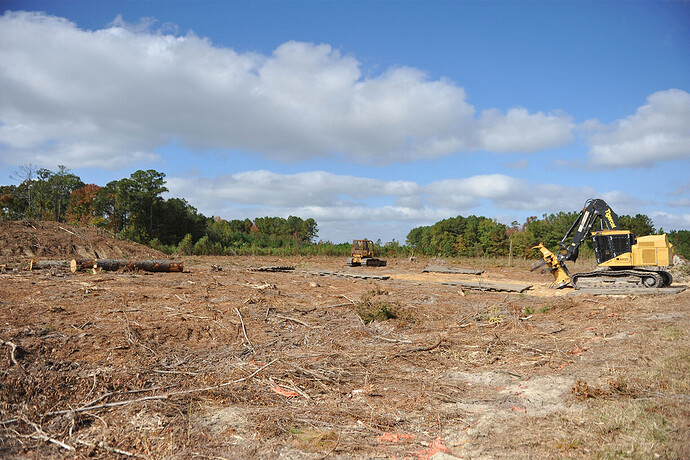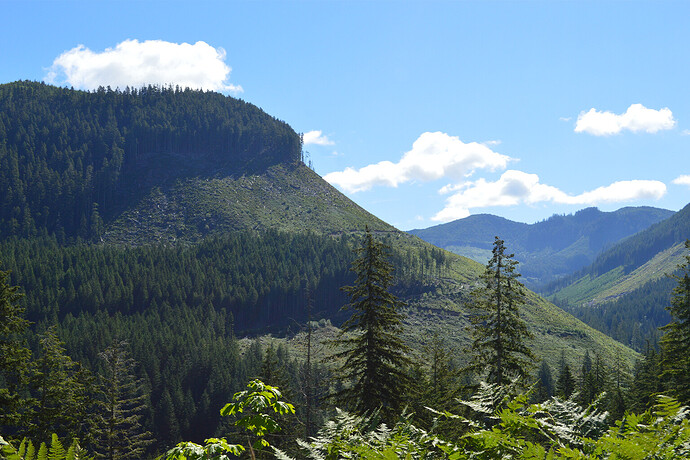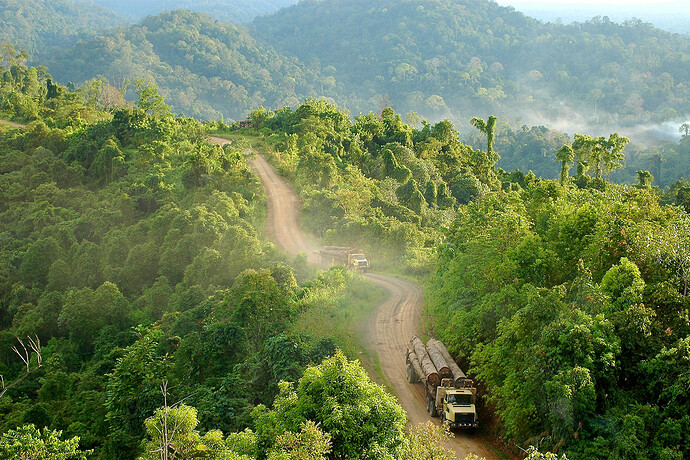- At a time when the world desperately needs to reduce its carbon emissions, global timber harvests to meet soaring demand for wood products — including paper and biomass for energy — could produce more than 10% of total global carbon emissions over coming decades, a new groundbreaking study finds.
- Global wood consumption could grow by 54% between 2010 and 2050, creating a demand for timber that would result in a “clear-cut equivalent” in area roughly the size of the continental U.S., adding 3.5 to 4.2 gigatons of carbon dioxide to the atmosphere annually for years to come.
- The study scientists warn that flawed national climate policies and faulty carbon accounting are failing to accurately forecast these potential carbon emissions resulting from the cutting of natural forests.
- The researchers point out that no natural forests need to be cut to meet the rising global demand for wood products. That demand could be well met by increasing wood production in already existing plantation forests.
Timber harvests to meet the world’s soaring demand for wood products will likely account for more than 10% of total global carbon emissions over coming decades, according to a new study by World Resources Institute scientists and published in Nature.
This explosion in emissions — three times those of aviation emissions — comes at a crucial time in the climate crisis when carbon discharges must drop rapidly to put a brake on rising record temperatures and reduce worsening climate catastrophes, which now seem to be in the news almost daily.
In real numbers, the scientists write, wood harvests will likely send an additional 3.5 to 4.2 gigatons of carbon dioxide into the atmosphere annually for years to come; global emissions in 2022 were a record 38.8 gigatons. The researchers note that while studies tend to correctly estimate amounts of released carbon, “the problem has been failing to account for the additional carbon forests overall would store if many were not being harvested.”
The new study suggests that global wood consumption “will likely grow by 54% between 2010 and 2050,” with wood harvests during that timeframe covering “clear-cut equivalents” of a total area roughly the size of the continental United States.
This 52-acre native forest in Edenton, North Carolina, U.S., was clear cut in late 2022 for both timber and for whole trees chipped to make wood pellets for bioenergy. The site was cleared for industrial development. Only trees for landscaping were to be replanted. Clear cuts like this around the world diminish global carbon storage. Image by Justin Catanoso.
This staggering amount of wood, and tree loss, will be needed to satisfy an expected 90% growth in demand for all timber products — with paper and cardboard growing by 130%, and wood fuel, including forest biomass for energy, growing by 20% by 2050.
“These [tree] losses in the near or medium-term — in addition to long-term losses — undermine the goals of the [2015] Paris Agreement and contradict justifiable commitments many governments have made to achieve carbon neutrality by 2050 to avoid dangerous climate change,” the scientists write.
Tim Searchinger, one of the WRI co-authors and an energy policy expert, confirmed that the enormous loss of tree cover to produce wood harvests comes in addition to ever-increasing deforestation of tropical forests and the clearing of the planet’s savannas for agriculture, extraction and development — all of which also combine to diminish carbon storage capacity.
Extensive logging of remote mountains on Vancouver Island in British Columbia, Canada, feeds the timber industry. Many of the trees taken here are old growth, more than 200 years in age. Timber companies typically replace the natural forest with monoculture tree farms that lack biodiversity and sequester far less carbon than the original natural forests. Image by Justin Catanoso.
Broken promises, deluded accounting
This continued one-two punch of global tree loss comes as world leaders pledge fruitlessly to curb deforestation while recognizing repeatedly that intact, biodiverse forests are the single most efficient means of absorbing emissions from global carbon pollution.
“Cutting down forests dumps most of the stored carbon into the atmosphere. And for at least a decade [after tree felling,] clear cuts act as carbon dead zones as newly planted trees take time to jumpstart photosynthesis and carbon uptake,” explained Dominick DellaSala, a forest ecologist with the Oregon NGO Wild Heritage, who was not involved in the study but concurred with its findings. “The luxury of time for logged forests to catch up to the carbon debt created by logging older forests is no longer possible, as the sand in the hourglass is running out to thwart increasingly severe climate impacts to nature and society,” he said.
The study goes to painstaking lengths to explain how nations delude themselves into thinking that wood harvests of natural forests are “carbon neutral” if done sustainably.
“By this, it’s usually meant that the quantity of wood harvested each year only matches the growth in a large forest area — sometimes [as large as] a whole country. This approach rests on the logic that if wood harvesting and tree growth cancel each [other] out, existing stores of carbon remain stable.” the authors write in an accompanying blog post.
But that national logic is faulty. It ignores the fact that in the absence of new wood harvests, natural forests would continue growing, taking more carbon out of the air, they write, adding, “Harvesting wood similarly makes us carbon poorer because it keeps forests from growing and storing more carbon that would otherwise wind up in the atmosphere.”
Trucks loaded with freshly cut logs transported for further processing, Gunung Lumut, East Kalimantan, Indonesia. Image by Jan van der Ploeg/CIFOR via Flickr (CC BY-NC-ND 2.0).
Good news, too?
The Nature study does offer what the authors describe as plausible solutions to the carbon costs of wood harvests, while pointing the way to still meeting global timber demand.
First off, they say, natural forests needn’t be cut to provide wood. The scientists point out that tens of millions of hectares of low-biodiversity “tree farms,” mistakenly referred to as forests by U.N. and national policies, are already intensively managed as plantations and can readily produce more wood on the same land.
“Steadily increasing the yields of existing plantations by 50% over 40 years — a real possibility — would reduce global emissions by 600 million tons per year on average during this time,” the scientists note. “More efficiently harvesting tropical forests, where many adjacent trees are typically killed when harvesting big trees, would increase those savings by another 200 million tons.”
The scientists also highlight the carbon-neutrality flaw in burning woody biomass for energy – which is increasing demand for forest harvesting in the U.S. Southeast, British Columbia, Eastern Europe, Scandinavia, and Southeast Asia. That investment should instead be made in zero-carbon solar and wind energy. Improving cook stoves in Africa would also reduce the harvest of wood for fuel.
This wood fuel use “if instead of growing by an estimated 20%… could decline by 40%, [then] global emissions would decline another 500 million tons,” the researchers estimate.
Harvested Amazon trees on their way downriver to market, either for final sale in Brazilian cities, or for shipment overseas for sale in lumber yards or home improvement stores in the U.S., Europe or elsewhere. Image © Fábio Nascimento exclusively for Mongabay.
The Nature study concludes: “These findings are, in a sense, good news because they imply that if people could reduce forest harvests, forest growth could do more to reduce atmospheric carbon, a potential mitigation ‘wedge’ that is rarely identified in climate strategies.”
“What’s most intriguing about WRI’s findings,” DellaSala said, “is the notion that existing [tree] plantations with modifications can more than meet the demand for wood fiber without cutting any more primary and older forests. That should be a global policy for all forested nations of the world.”
Banner image: The buttresses of this great ancient rainforest tree, which have kept it standing in the Brazilian Amazon for uncounted years, are no match for the industrial strength of a chainsaw powered by fossil fuels. Image © Fábio Nascimento exclusively for Mongabay.
Justin Catanoso, a regular Mongabay contributor, is a professor of journalism at Wake Forest University in North Carolina.




